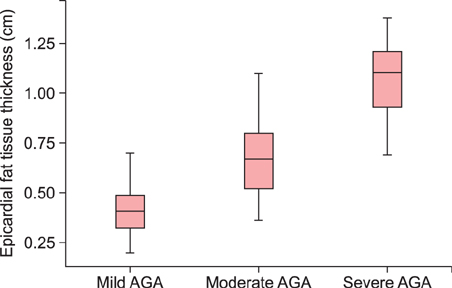Ann Dermatol.
2016 Apr;28(2):205-209. 10.5021/ad.2016.28.2.205.
The Relation of Androgenetic Alopecia Severity with Epicardial Fat Thickness
- Affiliations
-
- 1Department of Dermatology, Medical Faculty, Bozok University, Yozgat, Turkey. drecolgecen@hotmail.com
- 2Department of Cardiology, Medical Faculty, Bozok University, Yozgat, Turkey.
- 3Department of Radiology, Medical Faculty, Bozok University, Yozgat, Turkey.
- KMID: 2171378
- DOI: http://doi.org/10.5021/ad.2016.28.2.205
Abstract
- BACKGROUND
Androgenetic alopecia (AGA) is the most commonly encountered baldness pattern in men. Epicardial fat tissue is found on the cardiac surface between the myocardium and visceral pericardium. Both AGA and epicardial fat thickness (EFT) are related to coronary artery disease, which is also reflected by an increase in carotid intima media thickness (CIMT).
OBJECTIVE
The purpose of this study was to investigate the relation of AGA severity with EFT.
METHODS
One hundred twenty-six male patients with AGA aged 18 to 55 years without histories of chronic disease were enrolled. Subjects were divided into three groups (mild, moderate, and severe) on the basis of the Hamilton baldness scale as modified by Norwood. Maximum EFT was measured at end-systole on the midventricular free wall of the right ventricle. CIMT was also recorded for all patients.
RESULTS
The groups did not have statistically significant differences with respect to age, height, weight, body mass index, left ventricular ejection fraction, or left atrial diameter (p>0.05 for all comparisons), but the severe group had a higher EFT compared with the moderate (p<0.001; z score, -7.040) and mild groups (p<0.001; z score, -6.667). The moderate group also had higher EFT than the mild group (p<0.001; z score, -5.931). Mean CIMT value in the severe group was significantly higher compared with the value in the other groups.
CONCLUSION
The study showed that subjects in advanced stages of AGA had increased EFT, which was measured via echocardiography.
MeSH Terms
Figure
Reference
-
1. Stough D, Stenn K, Haber R, Parsley WM, Vogel JE, Whiting DA, et al. Psychological effect, pathophysiology, and management of androgenetic alopecia in men. Mayo Clin Proc. 2005; 80:1316–1322.
Article2. Piraccini BM, Alessandrini A. Androgenetic alopecia. G Ital Dermatol Venereol. 2014; 149:15–24.3. Hogan DJ, Chamberlain M. Male pattern baldness. South Med J. 2000; 93:657–662.
Article4. Agac MT, Bektas H, Korkmaz L, Cetin M, Erkan H, Gurbak I, et al. Androgenetic alopecia is associated with increased arterial stiffness in asymptomatic young adults. J Eur Acad Dermatol Venereol. 2015; 29:26–30.
Article5. Sharma KH, Jindal A. Association between androgenetic alopecia and coronary artery disease in young male patients. Int J Trichology. 2014; 6:5–7.
Article6. Traish AM. Adverse health effects of testosterone deficiency (TD) in men. Steroids. 2014; 88:106–116.
Article7. Vigen R, O'Donnell CI, Barón AE, Grunwald GK, Maddox TM, Bradley SM, et al. Association of testosterone therapy with mortality, myocardial infarction, and stroke in men with low testosterone levels. JAMA. 2013; 310:1829–1836.
Article8. Rebora A. Baldness and coronary artery disease: the dermatologic point of view of a controversial issue. Arch Dermatol. 2001; 137:943–947.9. Bolduc C, Shapiro J. Management of androgenetic alopecia. Am J Clin Dermatol. 2000; 1:151–158.
Article10. Grober ED. Testosterone deficiency and replacement: Myths and realities. Can Urol Assoc J. 2014; 8:7-8 Suppl 5. S145–S147.
Article11. Şengül C, Özveren O. Epicardial adipose tissue: a review of physiology, pathophysiology, and clinical applications. Anadolu Kardiyol Derg. 2013; 13:261–265.
Article12. Mazurek T, Zhang L, Zalewski A, Mannion JD, Diehl JT, Arafat H, et al. Human epicardial adipose tissue is a source of inflammatory mediators. Circulation. 2003; 108:2460–2466.
Article13. Yudkin JS, Eringa E, Stehouwer CD. "Vasocrine" signalling from perivascular fat: a mechanism linking insulin resistance to vascular disease. Lancet. 2005; 365:1817–1820.
Article14. Bachar GN, Dicker D, Kornowski R, Atar E. Epicardial adipose tissue as a predictor of coronary artery disease in asymptomatic subjects. Am J Cardiol. 2012; 110:534–538.
Article15. Norwood OT. Male pattern baldness: classification and incidence. South Med J. 1975; 68:1359–1365.
Article16. Lang RM, Bierig M, Devereux RB, Flachskampf FA, Foster E, Pellikka PA, et al. Chamber Quantification Writing Group. American Society of Echocardiography's Guidelines and Standards Committee. European Association of Echocardiography. Recommendations for chamber quantification: a report from the American Society of Echocardiography's Guidelines and Standards Committee and the Chamber Quantification Writing Group, developed in conjunction with the European Association of Echocardiography, a branch of the European Society of Cardiology. J Am Soc Echocardiogr. 2005; 18:1440–1463.
Article17. Iacobellis G, Willens HJ. Echocardiographic epicardial fat: a review of research and clinical applications. J Am Soc Echocardiogr. 2009; 22:1311–1319.
Article18. Nabati M, Saffar N, Yazdani J, Parsaee MS. Relationship between epicardial fat measured by echocardiography and coronary atherosclerosis: a single-blind historical cohort study. Echocardiography. 2013; 30:505–511.
Article19. Mohar DS, Salcedo J, Hoang KC, Kumar S, Saremi F, Erande AS, et al. Epicardial adipose tissue volume as a marker of coronary artery disease severity in patients with diabetes independent of coronary artery calcium: findings from the CTRAD study. Diabetes Res Clin Pract. 2014; 106:228–235.
Article20. Iacobellis G, Ribaudo MC, Assael F, Vecci E, Tiberti C, Zappaterreno A, et al. Echocardiographic epicardial adipose tissue is related to anthropometric and clinical parameters of metabolic syndrome: a new indicator of cardiovascular risk. J Clin Endocrinol Metab. 2003; 88:5163–5168.
Article21. Dogramaci AC, Balci DD, Balci A, Karazincir S, Savas N, Topaloglu C, et al. Is androgenetic alopecia a risk for atherosclerosis? J Eur Acad Dermatol Venereol. 2009; 23:673–677.
Article
- Full Text Links
- Actions
-
Cited
- CITED
-
- Close
- Share
- Similar articles
-
- Representative Trichoscopic Findings of Outpatients with Androgenetic Alopecia and Alopecia Areata
- Scalp Dermatoscopic Findings in Androgenetic Alopecia and Their Relations with Disease Severity
- Alopecia
- A Case of Combination Therapy with Finasteride and Low Dose Dutasteride in the Treatment of Androgenetic Alopecia
- A Clinical Study of Androgenetic Alopecia (III)


